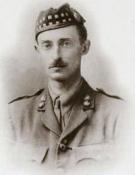
War Memorial
| Captain Seymour Frederick Auckland HURT | |
|
A Company, 1st Battalion Royal Scots Fusiliers Date of birth: 18th October 1879 Date of death: 18th October 1914 Killed in action aged 35 Commemorated on the Le Touret Memorial Panels 12 and 13 |

|
| Seymour Frederick Auckland Hurt was born at "The Outwoods", Duffield, in Derbyshire on the 18th of October 1879 the second son of Albert Frederic Hurt JP DL, a gentleman, and Alice (nee Delme-Radcliffe) Hurt of Alderwasley, Matlock in Derbyshire. He was christened at Wirksworth in Derbyshire on the 17th of November 1879. He was educated at Hazelwood School from 1889 to 1893 and at Harrow School where he was in Mr. J. Stogdon’s House from September 1893 to July 1898. While at Harrow he was a member of the Cricket XI in 1897 and 1898 where he was described as:- "A steady medium bowler. Poor field. Useful bat to fast bowling, very weak to slow." He was a member of the Football XI in 1897. He was commissioned as a 2nd Lieutenant in the 3rd Battalion Royal Scots Fusiliers (Militia) on the 4th of February 1899 and passed into the regular army in the Royal Scots Fusiliers with the rank of 2nd Lieutenant on the 17th of April 1900. From 1900 to 1908 he served in India where he was selected to be Brigade Signalling Officer for service on the frontier; he then served in Burma until 1910. He was promoted to Lieutenant on the 16th of April 1901 and to Captain on the 21st of January 1911, serving at the depot in Ayr until 1914. He was a keen sportsman, enjoying big game shooting, pig sticking and polo while he was in India; while at home he acted as Field Master to his brother’s foxhounds in Derbyshire. On the 8th of September 1914 he embarked for France with a draft of men from the Depot for his battalion; he saw action at the Battle of the Aisne. On the 18th of October 1914 the 1st Battalion Royal Scots Fusiliers was ordered to attack German positions at a chateau to the south of the village of Herlies near La Bassée, some 1,100 yards from their starting point. A battalion of the Lincolnshire Regiment was to be in support. The chateau was enclosed by a wood with the ground to the north of the wood sloping gradually up towards the La Bassée Road. The ground over which the attack was to made dipped considerably with a farm at the bottom, before rising again towards the wood. The Germans were dug in on three sides of the wood with two heavy guns and machine guns to the east of the wood. A network of ditches would have to be crossed and a smaller wood lay off to the left flank of the proposed attack. Seymour Hurt led A Company towards the centre of the chateau wood with B Company on his left and units from 7th Brigade on his right. As the Company advanced they were exposed to a storm of artillery, rifle and machine gun fire and were ordered to stop their advance when some five hundred yards from the wood as the battalion on their right from 7th Brigade had become held up. Also, C and D Companies, in reserve, had been heavily shelled with high explosive during the halt and had taken many casualties. At 5.15pm the advance was ordered to continue and the men began moving forward once again and it was now getting dark. At 6pm, when some sixty yards from the wood, the leading companies received orders to withdraw to a position in the rear due the inability of the units either side of the battalion to make headway. The retirement was made in good order. Casualties for the attack were two officers killed with four officers wounded and two missing along with twenty other ranks killed and one hundred wounded. Seymour Hurt had been killed instantaneously while leading his company into action on the evening of his 35th birthday. He was mentioned in Sir John French’s despatches of the 14th of January 1915. The following appeared in the Derbyshire Advertiser of the 6th of November 1914: - "By the news that Captain Hurt has lost his life in action, the war has been bought closely home to the many who knew him in his own neighbourhood. We have not heard any details, beyond the fact that the news reached Alderwasley on October 21. That he died as a brave and loyal soldier we can well believe. Cheery, kindhearted, a true gentleman, and a good sportsman, his loss will be mourned, not only by his family, but by all who knew him. we know that the deep sympathy of all who knew him in Alderwasley may go out to Mrs Hurt and a family. May God help and comfort them in this time of great sorrow." He is commemorated on the Alderwasley roll of honour. |
|
| Went on to Harrow School |
Back